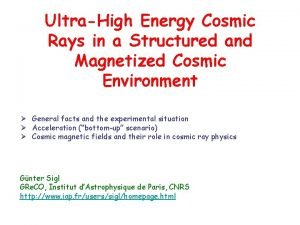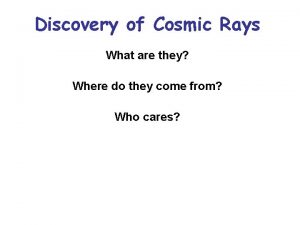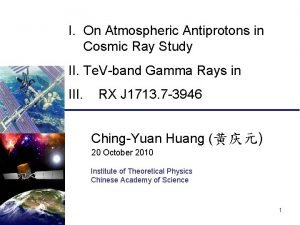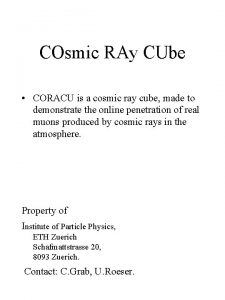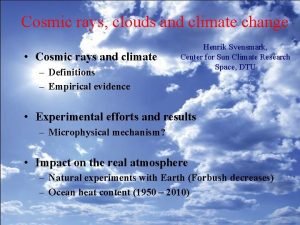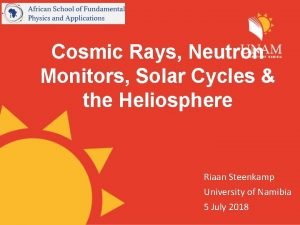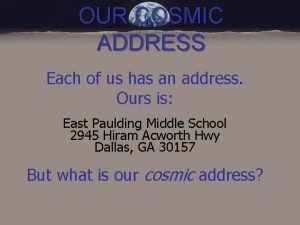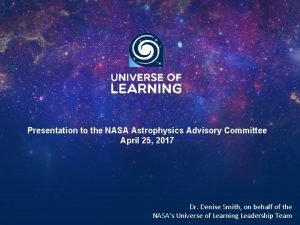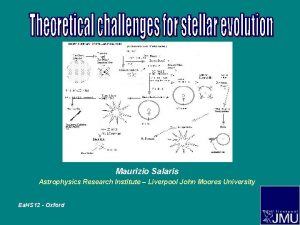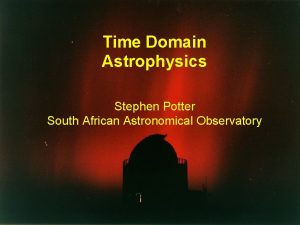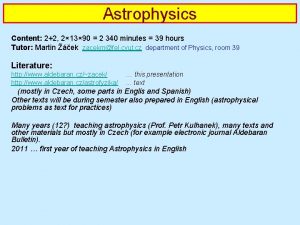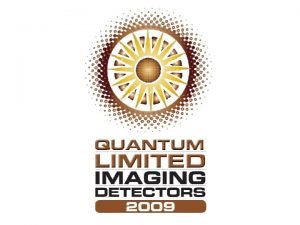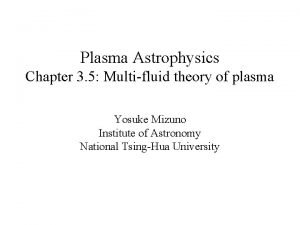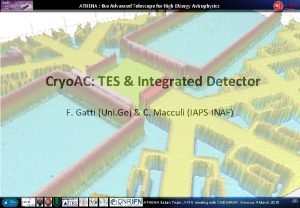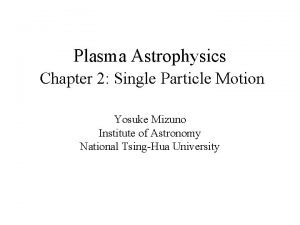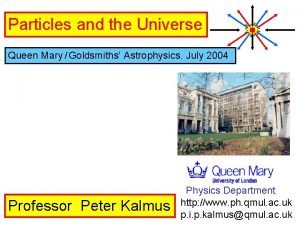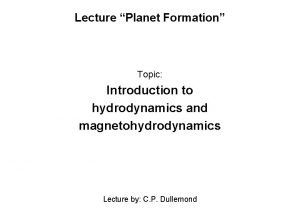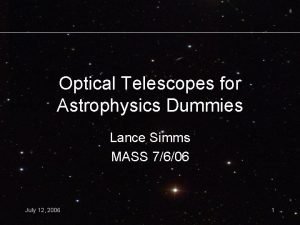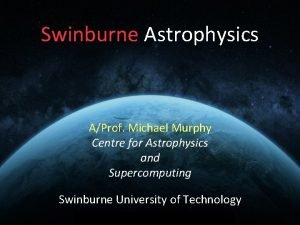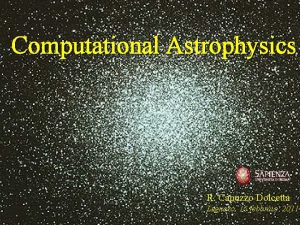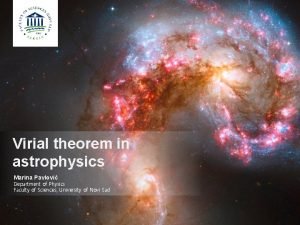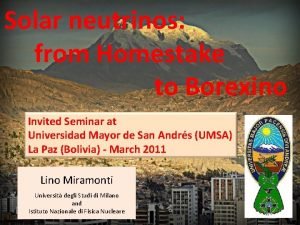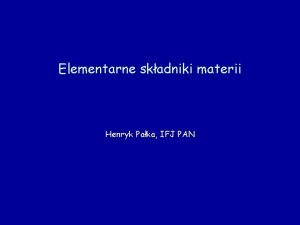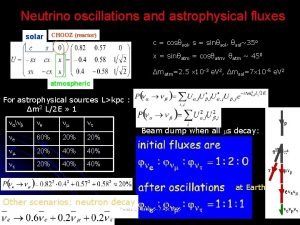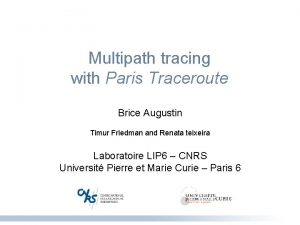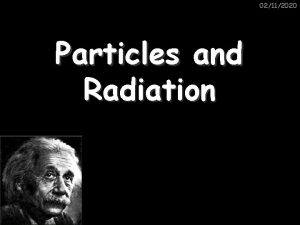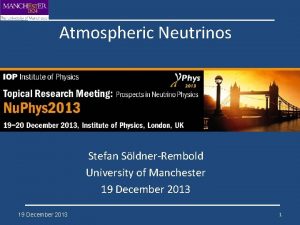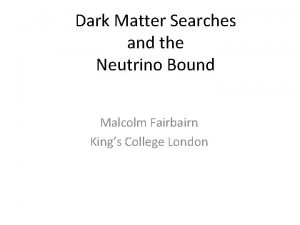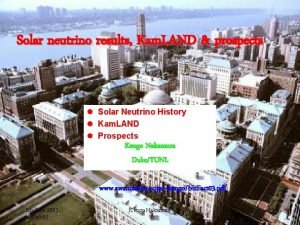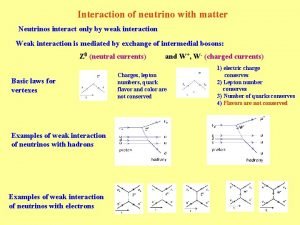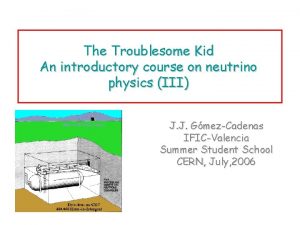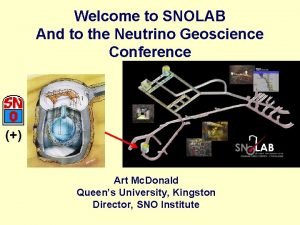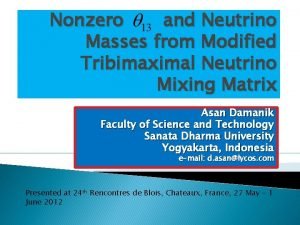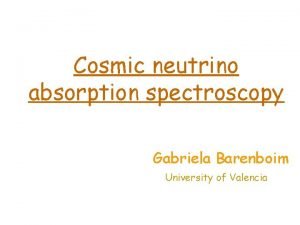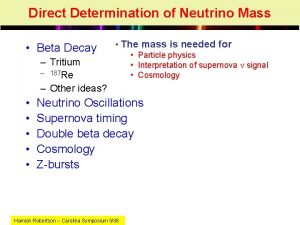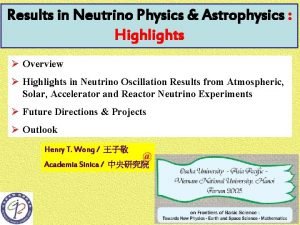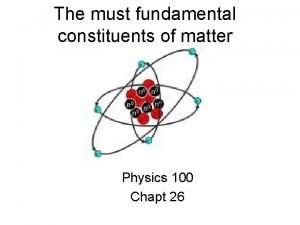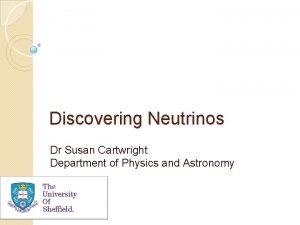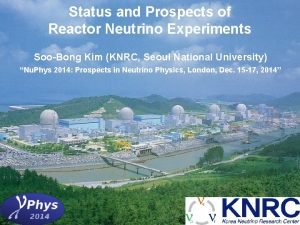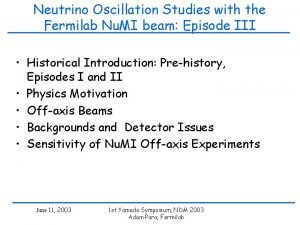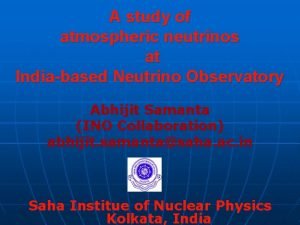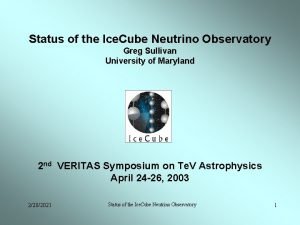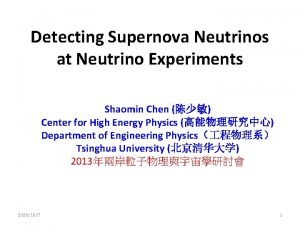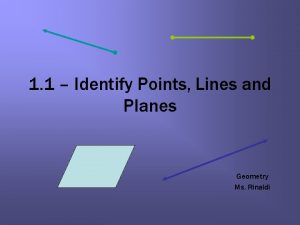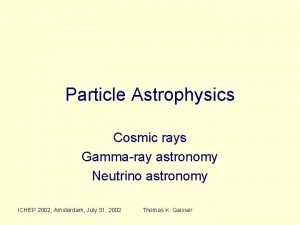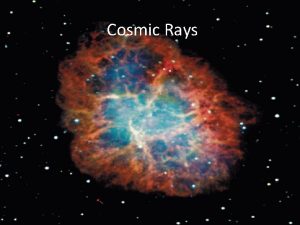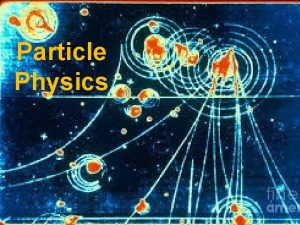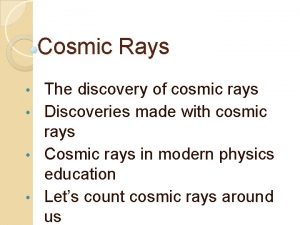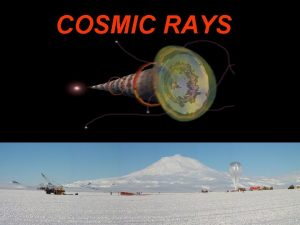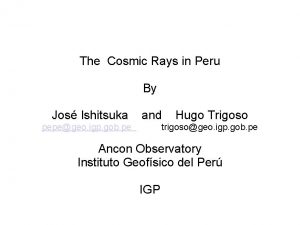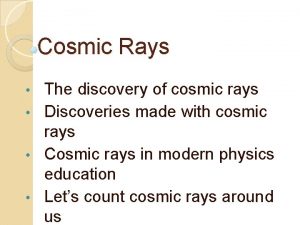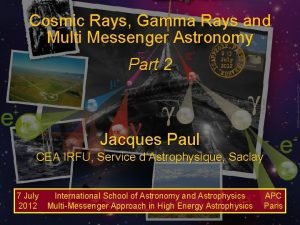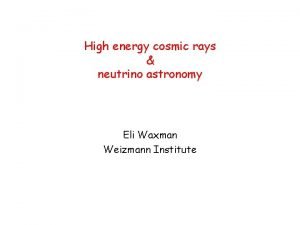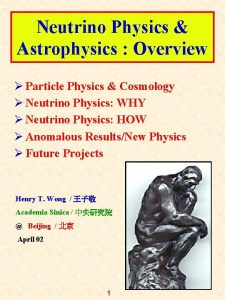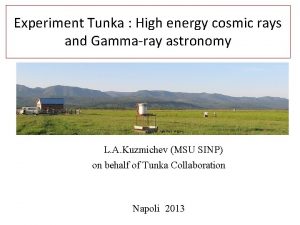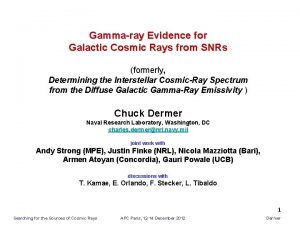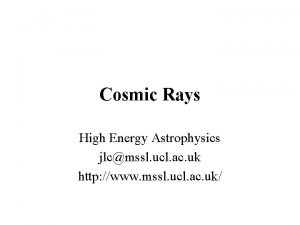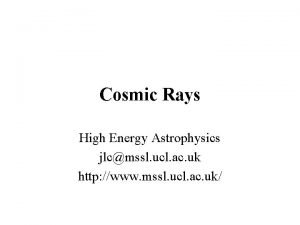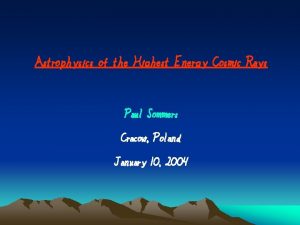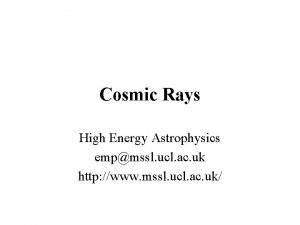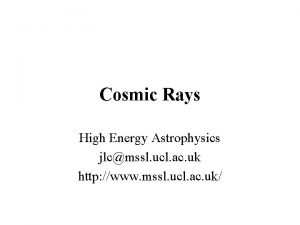Particle Astrophysics Cosmic rays Gammaray astronomy Neutrino astronomy

![Multi-messenger astronomy • Protons, g-rays, n, [gravitational waves] as probes of the high-energy universe Multi-messenger astronomy • Protons, g-rays, n, [gravitational waves] as probes of the high-energy universe](https://slidetodoc.com/presentation_image_h2/e6c50e5a4e914b3218e6d0129df776c8/image-2.jpg)














































- Slides: 48

Particle Astrophysics Cosmic rays Gamma-ray astronomy Neutrino astronomy ICHEP 2002, Amsterdam, July 31, 2002 Thomas K. Gaisser
![Multimessenger astronomy Protons grays n gravitational waves as probes of the highenergy universe Multi-messenger astronomy • Protons, g-rays, n, [gravitational waves] as probes of the high-energy universe](https://slidetodoc.com/presentation_image_h2/e6c50e5a4e914b3218e6d0129df776c8/image-2.jpg)
Multi-messenger astronomy • Protons, g-rays, n, [gravitational waves] as probes of the high-energy universe – Protons: directions scrambled by magnetic fields – Photons: straight-line propagation but • reprocessed in the sources • extragalactic backgrounds absorb Eg > Te. V – Neutrinos: straight-line propagation, unabsorbed, but difficult to detect ICHEP 2002, Amsterdam, July 31, 2002 Thomas K. Gaisser

Energetics of cosmic rays • Energy density: E Spectral Energy Distribution (linear inset most E < 100 Ge. V) ~ 10 -12 erg/cm 3 ~ B 2 / 8 p • Power needed: E / tesc galactic tesc ~ 3 x 106 yrs Power ~ 10 -26 erg/cm 3 s • Supernova power: 1051 erg per SN ~3 SN per century in disk ~ 10 -25 erg/cm 3 s • SN model of galactic CR Power spectrum from shock acceleration, propagation ICHEP 2002, Amsterdam, July 31, 2002 Thomas K. Gaisser Kinetic energy per nucleus

Problems of simplest SNR shock model • Expected shape of spectrum: – Differential index a ~ 2. 1 for diffusive shock acceleration aobserved ~ 2. 7; asource ~2. 1; Da ~ 0. 6 tesc(E) ~ E-0. 6 • c tesc Tdisk ~100 Te. V • Isotropy problem • • Expect p + gas g (Te. V) for certain SNR – Need nearby target as shown in picture from Nature (April 02) – Interpretation uncertain; see • – Problem of elusive p 0 g-rays • Emax ~ bshock Ze x B x Rshock – Emax ~ Z x 100 Te. V with exponential cutoff of each component – But spectrum continues to higher energy: • Emax problem ICHEP 2002, Amsterdam, July 31, 2002 Enomoto et al. , Aharonian (Nature); Reimer et al. , astro-ph/0205256 Thomas K. Gaisser

Spectrum normalizes atmospheric n Contained events nm m events • Ge. V to Te. V important for atmospheric n • Good agreement < 100 Ge. V – AMS, BESS • Lack of Te. V data; new expts: – Magnetic spectrometers: • PAMELA (2003) • AMS on Space Station (2005) • Meanwhile, new m-flux measurements Em > 100 Ge. V – Timmermans’ talk on L 3+C – Somewhat below previous measurements ICHEP 2002, Amsterdam, July 31, 2002 Thomas K. Gaisser TKG & Honda, hep-ph/0203272

Knee of spectrum • Differential spectral index changes at ~ 3 x 1015 e. V – a = 2. 7 a = 3. 0 – Continues to 3 x 1018 e. V – Expect exp{-E / Z Emax} cutoff for each Z Knee • Fine-tuning problem: – to match smoothly a new source with a steeper spectrum (Axford) – How serious is this? ICHEP 2002, Amsterdam, July 31, 2002 Thomas K. Gaisser

Speculation on the knee 1 component: a = 2. 7, Emax = Z x 30 Te. V; or Emax = Z x 1 Pe. V Total protons helium CNO Fe Mg… 3 components a=2. 7 a=2. 4 ICHEP 2002, Amsterdam, July 31, 2002 Thomas K. Gaisser K-H Kampert et al. , astro-ph/0204205

Transition to extragalactic origin? • Ankle new population of particles? • Suggestive evidence: – hardening of spectrum – change of composition Ankle New component with hard spectrum? ICHEP 2002, Amsterdam, July 31, 2002 • Measurements: – Energy – Depth of maximum (Xmax) – Nm / Ne Thomas K. Gaisser

Air shower detectors Sketch of ground array with fluorescence detector – Auger realizes this concept (talk of G. Matthiae) Hi-Res stereo fluorescence detector (D. Bergman’s talk) AGASA (Akeno, Japan) 100 km 2 ground array ICHEP 2002, Amsterdam, July 31, 2002 Thomas K. Gaisser

Measuring the energy of UHECR • Ground array samples shower front – Well-defined acceptance – Simulation relates observed ground parameter to energy • Fluorescence technique tracks shower profile – Track-length integral gives calorimetric measure of energy – Xmax sensitive to primary mass: Xmax ~ L ln(E 0/A) ICHEP 2002, Amsterdam, July 31, 2002 Thomas K. Gaisser

Xmax vs Energy • Protons penetrate deeper into atmosphere • Heavy nuclei develop higher up • Plot shows a summary of data over 5 decades • Several techniques • Some dependence on models of hadronic interactions (R. Engel’s talk) ICHEP 2002, Amsterdam, July 31, 2002 Thomas K. Gaisser

Xmax vs Energy • Lines indicate trend of data: • Light to heavy above the “knee” (~1016 1017 e. V) • Heavy to light at the “ankle” (~1018 1019 e. V) • AGASA looks at m/e ratio in shower front and sees no evidence for change of composition at the ankle ICHEP 2002, Amsterdam, July 31, 2002 Thomas K. Gaisser

Energy of extragalactic component • Energy density: – CR > ~ 2 x 10 -19 erg/cm 3 – Estimate requires extrapolation of UHECR to low energy • Power required – > CR/1010 yr ~ – 1. 3 x 1037 erg/Mpc 3/s – 10 -7 AGN/Mpc 3 • Need >1044 erg/s/AGN – 1000 GRB/yr • Need >3 x 1052 erg/GRB ICHEP 2002, Amsterdam, July 31, 2002 Assume extragalactic component with hard spectrum and GZK cutoff ~5 x 1019 e. V. a = 2. 0 : ideal shock acceleration a = 2. 25 : expected for relativistic shocks Integrate to estimate observed energy density Thomas K. Gaisser

Highest energy cosmic rays • GZK cutoff? – Expected from energy loss in 2. 7 o background for cosmological sources Attenuation length in microwave background ICHEP 2002, Amsterdam, July 31, 2002 Thomas K. Gaisser

Compare AGASA & Hi. Res Ground array • Exposure (103 km 2 yr sr): – AGASA: 1. 3 – Hi. Res (mono): 2. 2 • Number events >1020 – AGASA: 10 (+2? ) – Hi. Res (mono): 2? – Both detectors have energy-dependent acceptance (different) – Need more statistics and stereo results ICHEP 2002, Amsterdam, July 31, 2002 Thomas K. Gaisser Fluorescence detector

Models of UHECR • Bottom up (acceleration) – Jets of AGN • External • Internal (PIC models) – GRB fireballs – Accretion shocks in galaxy clusters – Galaxy mergers – Young SNR – Magnetars • Observed showers either protons (or nuclei) ICHEP 2002, Amsterdam, July 31, 2002 ( Incomplete list-Refs. in written version ) • Top-down (exotic) – Radiation from topological defects – *Decays of massive relic particles in Galactic halo – Resonant neutrino interactions on relic n’s (Z-burst) • Large fraction of g-showers (especially if local* origin) If no cutoff, require a significant contribution from nearby sources. Local overdensity of galaxies is insufficient if UHECR source distribution follows distribution of galaxies. Thomas K. Gaisser

Biggest event Fly’s Eye, Ap. J. 441 (1995) 295 • Comparison to – Proton showers – Iron showers – g showers ICHEP 2002, Amsterdam, July 31, 2002 Thomas K. Gaisser

Horizontal air showers • Most of shower absorbed, mostly muons survive to the ground • Heavy primaries produce more m • Incident photons produce few m • Analysis of vintage (aged ~25 yrs) data from Haverah Park array possible with modern simulation tools • Results place interesting limits on Top-Down models: • UHE events from decaying, massive relics accumulated in the Galactic halo would be mostly photon-induced showers. Such models are therefore disfavored • Similar limit on g/p from AGASA ICHEP 2002, Amsterdam, July 31, 2002 Thomas K. Gaisser

Auger hybrid event Fluorescence detector view “Engineering Array”: SD with 40 modules ~ 100 km 2 viewed by fluorescence detector. Now operating in Argentina. 100 more tanks running in 2003. Nearly horizontal event of 40 -station engineering array Surface detector view ICHEP 2002, Amsterdam, July 31, 2002 Thomas K. Gaisser

Active Galaxies: Jets Radio Galaxy 3 C 296 (AUI, NRAO). --Jets extend beyond host galaxy. VLA image of Cygnus A ICHEP 2002, Amsterdam, July 31, 2002 Drawing of AGN core Thomas K. Gaisser

Egret blazars • Blazars are AGN with jet illuminating observer. • Two-component spectra interpreted as synchrotron radiation (low energy) plus inverse Compton generated by high-energy electrons accelerated to high energy in relativistic jets (G ~ 10). • A few nearby blazars have spectra extending to > Te. V observed by ground-based Imaging Atmospheric Cherenkov Telescopes (IACT). ICHEP 2002, Amsterdam, July 31, 2002 Thomas K. Gaisser

AGN Mulitwavelength observations Example of Mrk 421 with new (preliminary) result from STACEE ~100 Ge. V • SSC, EC, PIC models – 1 st peak from electron synchrotron radiation – 2 nd peak model-dependent; predict n flux if PIC – Interpretation complex: ICHEP 2002, Amsterdam, July 31, 2002 UV Te. V X-ray mm Radio • Sources variable • Locations of peaks depend on source-- factor of >100 range of peak energy • New detectors (GLAST, HESS, MAGIC, VERITAS) will greatly expand number, variety of sources IR Thomas K. Gaisser Ge. V g (Egret)

Solar arrays for g-ray astronomy explore down to ~100 Ge. V: Celeste CELESTE, STACEE in operation STACEE ICHEP 2002, Amsterdam, July 31, 2002 Thomas K. Gaisser

Te. V g Blazars • Five detected Mrk 421 (Z = 0. 031) Mrk 501 (Z = 0. 034) 1 ES 2344+514 (Z = 0. 044) 1 H 1426+428 (Z = 0. 129) 1 ES 1959+650 (Z = 0. 048)* * Whipple, IAU Circular 17 May 2002 • Emax vs Z probes era of galaxy-formation through IR background ICHEP 2002, Amsterdam, July 31, 2002 Thomas K. Gaisser

Blazar spectra at high energy • Mrk 421 & Mrk 501, both at z ~. 03 – Cutoffs • Intrinsic? • Effect of propagation? – Variable sources • Low intensity – softer spectrum • Interpretation under debate E/Te. V igh ow – Need more observations of more sources at various redshifts ICHEP 2002, Amsterdam, July 31, 2002 HEGRA plots from Aharonian et al. astro-ph/0205499. Different Ecut of 421 and 501 suggest cutoffs are intrinsic. Comparable analysis of Whipple extends to lower energy. Seeing comparable cutoffs, they suggest effect is due to propagation. Krennrich et al. , Ap. J. 560 (2002) L 45 Thomas K. Gaisser

Sky map from the Milagro detector Milagro is a compact air shower detector that uses a 60 x 80 m water Cherenkov pool covered and surrounded by air shower detectors. Mrk 421 ICHEP 2002, Amsterdam, July 31, 2002 Thomas K. Gaisser

Detectors for gamma-ray astronomy Egret 1991 -2000 Future Presently running IACT Solar arrays All-sky dets. Whipple STACEE Tibet ASg CAT Celeste ARGO-YBJ Cangaroo II Hegra* Space dets. MILAGRO *Multiple telescope arrays for stereo operation HESS* (2002) SWIFT (2003) MAGIC (2003) AGILE (03/04) Cangaroo III * Glast papers by E. Bloom, L. Latronico AMS**Secondary Mode of operation VERITAS*(2005) ICHEP 2002, Amsterdam, July 31, 2002 GLAST (2005) Thomas K. Gaisser

Gamma-ray astronomy present and future Whipple 10 m (Arizona) Magic 17 m La Palma A. Morselli, S. Ritz ICHEP 2002, Amsterdam, July 31, 2002 Thomas K. Gaisser

H. E. S. S. • First events – June, 2002 ICHEP 2002, Amsterdam, July 31, 2002 Thomas K. Gaisser

Gamma-ray bursts • • Cosmological bursts – Studies of afterglows (ROTSE, Beppo-Sax ID) determine Z ~ 1 Hypernova or coalescing compact objects – Relativistic jets (G ~ 100) – Acceleration at internal shocks – Possible acceleration when jets interact with environment Are GRBs sufficiently powerful and numerous to supply the UHECRs? – This question currently under debate Soft Gamma Repeaters – Galactic magnetars, B ~ 1015 G – Satisfy ebc. BR > 1020 e. V • SWIFT to be launched in 2003 ICHEP 2002, Amsterdam, July 31, 2002 Thomas K. Gaisser

Neutrino Astronomy Skymap of upward events • SN 1987 A, Solar n • High-energy n astronomy – [DUMAND] – Baikal, AMANDA • Currently running • Atmospheric n’s detected • Limits on point sources, diffuse high-energy n’s, WIMPs, monopoles – Km 3 -scale projects getting underway AMANDA: astro-ph/0205019 vertically up ICHEP 2002, Amsterdam, July 31, 2002 Thomas K. Gaisser horizontally

South Pole Air Shower Experiment (SPASE) Dark sector Skiway AMANDA Dome Ice. Cube ICHEP 2002, Amsterdam, July 31, 2002 Thomas K. Gaisser AMANDA-II: 200 x 500 cylinder + 3 1 km strings, running since 2000

m cm-2 s-1 southern sky 10 -14 northern sky kand o i m a K r e up 4 years S e 170 days AMANDA-B 10 8 years MACRO 10 -15 -90 SS-433 Expected sensitivity AMANDA 97 -02 data -45 0 ICHEP 2002, Amsterdam, July 31, 2002 45 Thomas K. Gaisser declination (degrees) Mk-421 / ~ 1 90

Antares + Nemo, Nestor Km 3 in the Mediterranean Sea Ice. Cube in Antarctic ice Development of kilometer-scale telescopes. . . complementary sky-views and techniques AMANDA II Ice. Cube ICHEP 2002, Amsterdam, July 31, 2002 Thomas K. Gaisser

Skymaps and exposure to gamma-ray bursters BATSE 2706 GRBs Beppo-SAX 126 GRBs ANTARES location: Sources rise and set; partial overlap with South Pole F. O. V. Plot by Teresa Montaruli is grey-scale image of sky coverage for upward events (black = no coverage, white = full coverage). Applies to En< Pe. V when Earth needed to shield against downward events. AMANDA location: Sources always at same elevation, a possible advantage for variable sources ICHEP 2002, Amsterdam, July 31, 2002 Thomas K. Gaisser

Neutrino flavor ID • P p nm + m e + n m – nm : ne : nt ~ 2 : 1 : 0 at production – oscillations give 1 : 1 at Earth • En < Pe. V – nm: upward m track – ne, nt: cascades • En > Pe. V – Rt ~ 50 m / Et (Pe. V) – nt gives double bang or “lollipop” signature (large cascade preceded or followed by a long, “cool” track) ICHEP 2002, Amsterdam, July 31, 2002 Thomas K. Gaisser

n Propagation in the Earth • Lower hemisphere 50% opaque for En ~ Pe. V • Regeneration of nt nt t n cascade: – Look for excess of upward cascades between 0. 1 and 10 Pe. V – • For En > Pe. V can use downward neutrinos as well as upward ICHEP 2002, Amsterdam, July 31, 2002 90% Allowed directions at 100 Te. V ~ 50% allowed at 1 Pe. V Earth absorbs ~90% of upward n for En > 10 Pe. V Thomas K. Gaisser

Expected signals in km 3 Diffuse (unresolved) sources--signature: • hard spectrum • charm background uncertain • Possible point sources: – Galactic • SNR 0 - 10 events / yr • m-quasars 0. 1 - 5 / burst • ~ 100 / yr, steady source – Extra-galactic 1800 / yr • AGN jets 0 -100 / yr • GRB precursor (~100 s) 200 30 – ~ 1000 bursts / yr – ~ 0. 2 events / burst 15 ~1 • GRB jet after breakout – smaller mean signal / burst • Nearby bursts give larger signal in both cases ICHEP 2002, Amsterdam, July 31, 2002 Thomas K. Gaisser charm <1

Proposed detectors for En ~ Ee. V • Air shower arrays – Signature: Horizontal EAS – Veff ~ 10 m. w. e. x area • e. g. 30 Gt for Auger • (Acceptance ~30 x larger for nt in Auger) • >1000 Gt for EUSO, OWL • Note: despite larger Veff , rates may be comparable or smaller than in Km 3 detectors with lower Ethreshold by an amount depending on source spectrum • Radio detectors – RICE (antennas in S. P. ice) – ANITA (antennas on longduration Antarctic balloon) – SALSA (…in salt domes) – GLUE (Goldstone antenna search for n interact in moon) ICHEP 2002, Amsterdam, July 31, 2002 Thomas K. Gaisser OWL

Summary • Need more statistics and cross-calibration for ultra-high energy cosmic rays • Expect another leap in g-astronomy with GLAST and new ground telescope arrays • Kilometer-scale neutrino telescopes to open new window on energetic Universe • Many active and new experiments in this rapidly developing field -- stay tuned! ICHEP 2002, Amsterdam, July 31, 2002 Thomas K. Gaisser

Diffuse galactic secondaries p + gas p 0, p+/-, antiprotons • p 0 g g [p+/- n] Phys. Rev. Lett. 88 (2002) 051101 • Hard g-spectrum suggests some contribution from collisions at sources BESS antiprotons, 1997, ’ 99, ’ 00. • Fully consistent with secondary production by collisions in ISM followed by solar modulation varying with solar cycle ICHEP 2002, Amsterdam, July 31, 2002 Thomas K. Gaisser

Lessons from the heliosphere • ACE energetic particle fluences: • Smooth spectrum – composed of several distinct components: • Most shock accelerated • Many events with different shapes contribute at low energy (< 1 Me. V) • Few events produce ~10 Me. V – Knee ~ Emax of a few events – Ankle at transition from heliospheric to galactic cosmic rays ICHEP 2002, Amsterdam, July 31, 2002 R. A. Mewaldt et al. , A. I. P. Conf. Proc. 598 (2001) 165 Thomas K. Gaisser

Heliospheric cosmic rays • ACE--Integrated fluences: – Many events contribute to lowenergy heliospheric cosmic rays; – fewer as energy increases. – Highest energy (75 Me. V/nuc) is dominated by low-energy galactic cosmic rays, and this component is again smooth • Beginning of a pattern? R. A. Mewaldt et al. , A. I. P. Conf. Proc. ICHEP 2002, Amsterdam, July 31, 2002 Thomas K. Gaisser 598 (2001) 165

Reconstruction Handles for neutrino astronomy up/down Atmospheric m (calibration beam) energy source direction time x Diffuse , EHE events x x Point Sources: AGN, WIMPs x x x GRBs x x x ICHEP 2002, Amsterdam, July 31, 2002 Thomas K. Gaisser x

Energy resolution • Systematics – DE / E ~20% for ~1018 e. V • By cross-calibrating different detectors • By using different models • By comparing spectra of different experiments and techniques • Fluctuations in Smax • underestimate E if measured at max, • overestimate if past max ICHEP 2002, Amsterdam, July 31, 2002 Thomas K. Gaisser

GRB model Bahcall & Waxman, hep-ph/0206217 • Assumes E-2 spectrum at source • 2. 5 x 1053 erg/GRB • 0. 4 x 1037 erg/Mpc 3/s • Evolution like starformation rate • GZK losses included • Galactic extragalactic transition ~ 1019 e. V ICHEP 2002, Amsterdam, July 31, 2002 Thomas K. Gaisser

Curves 2, 3, 4 with local overdensity of sources. 2 is observed overdensity. AGN model Berezinsky et al. , hep-ph/0204357 • Assumes two-component spectra – steep at high energy • 1039 erg/Mpc 3/s – note high value • Evolution, GZK losses • Compares to AGASA data, cannot explain ~5 events • Transition to extragalactic at low energy ICHEP 2002, Amsterdam, July 31, 2002 Thomas K. Gaisser

ICHEP 2002, Amsterdam, July 31, 2002 Thomas K. Gaisser
 Cosmic rays
Cosmic rays Cosmic rays discoverer
Cosmic rays discoverer Cosmic ray
Cosmic ray Cosmic ray cube
Cosmic ray cube Cosmic rays and clouds
Cosmic rays and clouds Cosmic rays
Cosmic rays Cosmic address in order
Cosmic address in order Learning astronomy by doing astronomy
Learning astronomy by doing astronomy Learning astronomy by doing astronomy
Learning astronomy by doing astronomy Learning astronomy by doing astronomy activity 1 answers
Learning astronomy by doing astronomy activity 1 answers Nasa astrophysics advisory committee
Nasa astrophysics advisory committee Maurizio salaris
Maurizio salaris Time domain astrophysics
Time domain astrophysics 13,90/2
13,90/2 Rit astrophysics
Rit astrophysics Astrophysics equations
Astrophysics equations Advanced telescope for high energy astrophysics
Advanced telescope for high energy astrophysics Astrophysics
Astrophysics Queen mary astrophysics
Queen mary astrophysics Mhd equations
Mhd equations Astrophysics for dummies
Astrophysics for dummies Swinburne astrophysics
Swinburne astrophysics Astrophysics
Astrophysics Virial theorem in astrophysics
Virial theorem in astrophysics Solar neutrino
Solar neutrino Lekka cząstka elementarna mion elektron lub neutrino
Lekka cząstka elementarna mion elektron lub neutrino Neutrino
Neutrino Neutrino load balancer
Neutrino load balancer Lepton number table
Lepton number table Neutrino
Neutrino Neutrino
Neutrino Nakamura
Nakamura Neutrino interaction with matter
Neutrino interaction with matter Neutrino
Neutrino Solar neutrino
Solar neutrino Neutrino
Neutrino Gabriela barenboim
Gabriela barenboim Neutrino mass
Neutrino mass Neutrino mass
Neutrino mass Neutrino symbol
Neutrino symbol Neutrino beteckning
Neutrino beteckning Dr susan cartwright
Dr susan cartwright Neutrino
Neutrino Neutrino
Neutrino Neutrino
Neutrino Neutrino
Neutrino The leptons
The leptons Neutrino
Neutrino Example of opposite rays
Example of opposite rays
